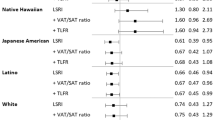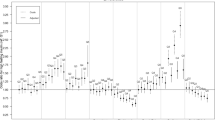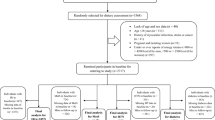Abstract
Background/objectives:
Impaired fasting plasma glucose (IFG) and impaired glucose tolerance (IGT) predict development of type 2 diabetes (T2D), but display different pathophysiology for T2D. We studied the association of selected food items and nutrients with IFG, IGT and combined IFG and IGT (IFG+IGT), independent of cardiorespiratory fitness (VO2max).
Subjects/methods:
In a population-based sample of 1261 individuals, aged 58–78 years, we identified 126 subjects with IFG, 97 with IGT and 49 with simultaneous IFG and IGT by an oral glucose tolerance test. Dietary intake was assessed by 4-day food records. Cardiorespiratory fitness was assessed by defining maximal oxygen uptake (VO2max) from respiratory gas analysis during a maximal symptom-limited exercise stress test on a bicycle ergometer.
Results:
Increased intake of saturated fat was associated with higher odds for IFG (OR 1.07; 1.01–1.14) after adjustment for age, gender, VO2max and energy misreporting variable. Consumption of additional whole-grain bread (50 g/1000 kcal) and intake of dietary fiber (g/1000 kcal) were inversely associated with IGT (OR 0.61; 0.41–0.92, OR 0.91; CI 0.85–0.97, respectively).
Conclusion:
Dietary fiber and sources of cereal fiber are negatively associated with IGT, and saturated fat intake is positively associated with IFG, but not with IGT. The present data give practical dietary means at the population level for the elimination of prediabetic conditions.
This is a preview of subscription content, access via your institution
Access options
Subscribe to this journal
Receive 12 print issues and online access
$259.00 per year
only $21.58 per issue
Buy this article
- Purchase on Springer Link
- Instant access to full article PDF
Prices may be subject to local taxes which are calculated during checkout

Similar content being viewed by others
References
Shaw JE, Sicree RA, Zimmet PZ . Global estimates of the prevalence of diabetes for 2010 and 2030. Diabetes Res Clin Pract 2010; 87, 4–14.
American Diabetes Association. Economic costs of diabetes in the U.S. In 2007. Diabetes Care 2008; 31, 596–615.
Pan XR, Li GW, Hu YH, Wang JX, Yang WY, An ZX et al. Effects of diet and exercise in preventing NIDDM in people with impaired glucose tolerance. The Da Qing IGT and Diabetes Study. Diabetes Care 1997; 20, 537–544.
Tuomilehto J, Lindstrom J, Eriksson JG, Valle TT, Hamalainen H, Ilanne-Parikka P et al. Prevention of type 2 diabetes mellitus by changes in lifestyle among subjects with impaired glucose tolerance. N Engl J Med 2001; 344, 1343–1350.
Knowler WC, Barrett-Connor E, Fowler SE, Hamman RF, Lachin JM, Walker EA et al. Reduction in the incidence of type 2 diabetes with lifestyle intervention or metformin. N Engl J Med 2002; 346, 393–403.
Santaguida PL, Balion C, Hunt D, Morrison K, Gerstein H, Raina P et al. Diagnosis, Prognosis, and Treatment of Impaired Glucose Tolerance and Impaired Fasting Glucose. Summary, Evidence Report/Technology assessment no. 128 AHRQ Pub, Agency for Healthcare Research and Quality: Rockville, USA, 2005. Available at: http://www.ahrq.gov/clinic/epcsums/impglusum.pdf.
WHO/IDF. Definition and Diagnosis of Diabetes Mellitus and Intermediate Hyperglycemia: Report of a WHO/IDF Consultation. WHO, World Health Organization Report: Geneva, Switzerland, 2006, Available at: http://www.idf.org/webdata/docs/WHO_IDF_definition_diagnosis_of_diabetes.pdf.
Laakso M, Zilinskaite J, Hansen T, Boesgaard TW, Vanttinen M, Stancakova A et al. Insulin sensitivity, insulin release and glucagon-like peptide-1 levels in persons with impaired fasting glucose and/or impaired glucose tolerance in the EUGENE2 study. Diabetologia 2008; 51, 502–511.
Vessby B, Uusitupa M, Hermansen K, Riccardi G, Rivellese AA, Tapsell LC et al. Substituting dietary saturated for monounsaturated fat impairs insulin sensitivity in healthy men and women: The KANWU Study. Diabetologia 2001; 44, 312–319.
Summers LK, Fielding BA, Bradshaw HA, Ilic V, Beysen C, Clark ML et al. Substituting dietary saturated fat with polyunsaturated fat changes abdominal fat distribution and improves insulin sensitivity. Diabetologia 2002; 45, 369–377.
Juntunen KS, Laaksonen DE, Poutanen KS, Niskanen LK, Mykkanen HM . High-fiber rye bread and insulin secretion and sensitivity in healthy postmenopausal women. Am J Clin Nutr 2003; 77, 385–391.
Laaksonen DE, Toppinen LK, Juntunen KS, Autio K, Liukkonen KH, Poutanen KS et al. Dietary carbohydrate modification enhances insulin secretion in persons with the metabolic syndrome. Am J Clin Nutr 2005; 82, 1218–1227.
Rojo-Martinez G, Esteva I, Ruiz de Adana MS, Garcia-Almeida JM, Tinahones F, Cardona F et al. Dietary fatty acids and insulin secretion: a population-based study. Eur J Clin Nutr 2006; 60, 1195–1200.
Weickert MO, Roden M, Isken F, Hoffmann D, Nowotny P, Osterhoff M et al. Effects of supplemented isoenergetic diets differing in cereal fiber and protein content on insulin sensitivity in overweight humans. Am J Clin Nutr 2011; 94, 459–471.
American Diabetes Association, Bantle JP, Wylie-Rosett J, Albright AL, Apovian CM, Clark NG et al. Nutrition recommendations and interventions for diabetes: a position statement of the American Diabetes Association. Diabetes Care 2008; 31 (Suppl 1), S61–S78.
Komulainen P, Kivipelto M, Lakka TA, Savonen K, Hassinen M, Kiviniemi V et al. Exercise, fitness and cognition—a randomised controlled trial in older individuals: the DR's EXTRA study. Eur Geriatr Med 2010; 1, 266–272.
Pietinen P, Hartman AM, Haapa E, Rasanen L, Haapakoski J, Palmgren J et al. Reproducibility and validity of dietary assessment instruments. I. A self-administered food use questionnaire with a portion size picture booklet. Am J Epidemiol 1988; 128, 655–666.
Rastas M, Seppanen R, Knuts L-R, Hakala P, Karttila V . Nutrient Composition of Foods. Publications of the Social Insurance Institution: Helsinki, Finland, 1997.
Goldberg GR, Black AE, Jebb SA, Cole TJ, Murgatroyd PR, Coward WA et al. Critical evaluation of energy intake data using fundamental principles of energy physiology: 1. Derivation of cut-off limits to identify under-recording. Eur J Clin Nutr 1991; 45, 569–581.
Schofield WN . Predicting basal metabolic rate, new standards and review of previous work. Hum Nutr Clin Nutr 1985; 39 (Suppl 1), 5–41.
Hassinen M, Lakka TA, Savonen K, Litmanen H, Kiviaho L, Laaksonen DE et al. Cardiorespiratory fitness as a feature of metabolic syndrome in older men and women: the Dose-Responses to Exercise Training study (DR's EXTRA). Diabetes Care 2008; 31, 1242–1247.
Lakka TA, Laaksonen DE, Lakka HM, Mannikko N, Niskanen LK, Rauramaa R et al. Sedentary lifestyle, poor cardiorespiratory fitness, and the metabolic syndrome. Med Sci Sports Exerc 2003; 35, 1279–1286.
Nettleton JA, McKeown NM, Kanoni S, Lemaitre RN, Hivert MF, Ngwa J et al. Interactions of dietary whole-grain intake with fasting glucose- and insulin-related genetic loci in individuals of European descent: a meta-analysis of 14 cohort studies. Diabetes Care 2010; 33, 2684–2691.
Schulze MB, Schulz M, Heidemann C, Schienkiewitz A, Hoffmann K, Boeing H . Fiber and magnesium intake and incidence of type 2 diabetes: a prospective study and meta-analysis. Arch Intern Med 2007; 167, 956–965.
Hirvonen T, Mannisto S, Roos E, Pietinen P . Increasing prevalence of underreporting does not necessarily distort dietary surveys. Eur J Clin Nutr 1997; 51, 297–301.
Lafay L, Mennen L, Basdevant A, Charles MA, Borys JM, Eschwege E et al. Does energy intake underreporting involve all kinds of food or only specific food items? Results from the Fleurbaix Laventie Ville Sante (FLVS) study. Int J Obes Relat Metab Disord 2000; 24, 1500–1506.
Sluijs I, van der Schouw YT, van der ADL, Spijkerman AM, Hu FB, Grobbee DE et al. Carbohydrate quantity and quality and risk of type 2 diabetes in the European Prospective Investigation into Cancer and Nutrition-Netherlands (EPIC-NL) study. Am J Clin Nutr 2010; 92, 905–911.
Mattisson I, Wirfalt E, Aronsson CA, Wallstrom P, Sonestedt E, Gullberg B et al. Misreporting of energy: prevalence, characteristics of misreporters and influence on observed risk estimates in the Malmo Diet and Cancer cohort. Br J Nutr 2005; 94, 832–842.
LaMonte MJ, Blair SN . Physical activity, cardiorespiratory fitness, and adiposity: contributions to disease risk. Curr Opin Clin Nutr Metab Care 2006; 9, 540–546.
Sawada SS, Lee IM, Naito H, Noguchi J, Tsukamoto K, Muto T et al. Long-term trends in cardiorespiratory fitness and the incidence of type 2 diabetes. Diabetes Care 2010; 33, 1353–1357.
Ostergard T, Andersen JL, Nyholm B, Lund S, Nair KS, Saltin B et al. Impact of exercise training on insulin sensitivity, physical fitness, and muscle oxidative capacity in first-degree relatives of type 2 diabetic patients. Am J Physiol Endocrinol Metab 2006; 290, E998–1005.
Savonen K, Krachler B, Hassinen M, Komulainen P, Kiviniemi V, Lakka TA et al. The current standard measure of cardiorespiratory fitness introduces confounding by body mass: the DR's EXTRA study. Int J Obes 2011; e-pub ahead of print 22 November 2011; doi: 10.1038/ijo.2011.212.
Acknowledgements
The DR's EXTRA Study was supported by grants to R Rauramaa by the Ministry of Education and Culture of Finland (722 and 627; 2004-2011), Academy of Finland (102318, 104943, 123885), Kuopio University Hospital, Finnish Diabetes Association, Finnish Foundation for Cardiovascular Research, Päivikki and Sakari Sohlberg Foundation and by grants from European Commission FP6 Integrated Project (EXGENESIS); LSHM-CT-2004-005272, City of Kuopio and Social Insurance Institution of Finland (4/26/2010).
Author information
Authors and Affiliations
Corresponding author
Ethics declarations
Competing interests
The authors declare no conflict of interest.
Rights and permissions
About this article
Cite this article
Heikkilä, H., Schwab, U., Krachler, B. et al. Dietary associations with prediabetic states—The DR's EXTRA Study (ISRCTN45977199). Eur J Clin Nutr 66, 819–824 (2012). https://doi.org/10.1038/ejcn.2012.23
Received:
Revised:
Accepted:
Published:
Issue Date:
DOI: https://doi.org/10.1038/ejcn.2012.23
Keywords
This article is cited by
-
Associations of linoleic acid with markers of glucose metabolism and liver function in South African adults
Lipids in Health and Disease (2020)
-
Combined low-saturated fat intake and high fitness may counterbalance diabetogenic effects of obesity: the DR’s EXTRA Study
European Journal of Clinical Nutrition (2013)



